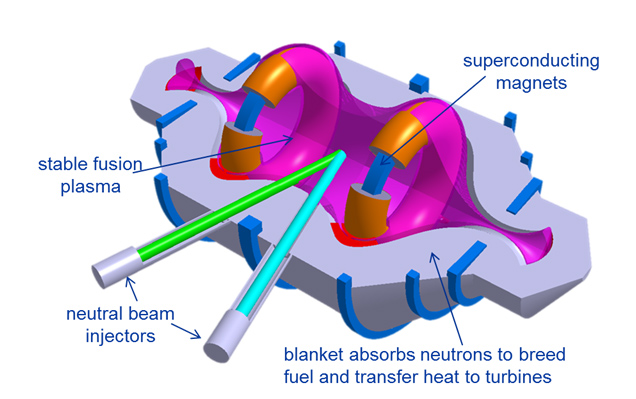I have been blogging about alternate approaches to nuclear fusion power reactors. If the scientists are able to create a working fusion reactor that can generate more energy that it consumes, it could be revolutionary for the power industry. Fusion reactors are generally designed to consume ions like hydrogen, deuterium, tritium and/or boron for fuel. Some produce fast neutrons but some don't. And none of them produce the kind of waste that is generated by a nuclear fission power reactor. Today I am going to talk about a fusion reactor project at the Skunk Works which is the experimental technology division of Lockheed Martin.
The Lockheed Martin Compact Fusion Reactor (CFR) utilizes a different design than the donut-shaped tokomak design which has been the basis for many fusion reactor experiments. Tokomak designs are limited in the amount of plasma that they can contain. This limitation has resulted in very big tokomak designs to hold as much plasma as possible. The CFR has borrowed magnetic confinement design elements from a number of different fusion research projects, taking the best of each. It is estimated that a CFR should be able to be one tenth the size of a tokomak that generates the same amount of power. The design can scale so a CFR the size of the ITER project would generate ten times as much power.
The basic shape of a CFR is a short tube with a bulge in the middle unlike the tokomak donut design and the Dynomak spherical design. Two neutral beam injectors send deuterium gas into the confinement chamber which is ringed by two donut-shaped superconducting magnets. Deuterium gas in the confinement chamber is heated by microwaves and fuses, releasing helium, neutrons and a lot of energy. The CFR has a feedback system which increases the confining magnetic field as the plasma move away from the center of the tube. The magnetic confinement is designed to have fewer open field lines than tokomak designs. A "blanket" surrounds the confinement chamber to absorb neutrons produced in the reaction and transfer heat to turbines to generate electricity.
The head of the Skunk Works lab says that they should be able to build a working prototype reactor after five generations of test devices. They hope to have a prototype in about five years. Within five years after the prototype they should be able to produce a commercial one hundred megawatt model for the energy market. The entire unit would be about twenty three by forty two feet. It could be transported on a semi truck trailer, installed and be working in a few weeks. CFRs are small enough to be used for propulsion on ships, submarines and big commercial planes. A plane with one of these reactors would be able to stay aloft indefinitely. It would never need refueling and would generate no pollution.
Artist's rendering of a Compact Fusion Reactor:
